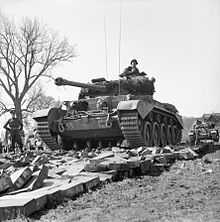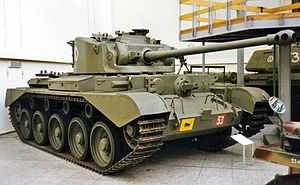Comet tank
| Tank, Cruiser, Comet I (A34) | |
|---|---|
|
Comet tank in the Militärhistorisches Museum der Bundeswehr | |
| Type | Cruiser tank |
| Place of origin | United Kingdom |
| Service history | |
| In service | December 1944 - 1958 (UK) |
| Used by | see Operators |
| Wars |
Second World War Korean War |
| Production history | |
| Designed | 1943 |
| Manufacturer | Leyland Motors Ltd |
| Produced | September 1944 |
| Number built | 1,186[1] |
| Specifications | |
| Weight |
32.7 long tons (laden) (33.53 tonnes) |
| Length | 21 ft 6 in (6.55 m) excluding gun |
| Width | 10 ft 1 in (3.04 m) |
| Height | 8 ft 6 in (2.67 m) |
| Crew | 5 (Commander, gunner, loader/operator, driver, hull gunner) |
|
| |
| Armour | 1.3–4.0 in (32–102 mm) |
Main armament |
77 mm HV 61 rounds |
Secondary armament |
2 x 7.92 mm Besa MG[note 1] 5,175 rounds |
| Engine |
Rolls-Royce Meteor Mark III V12 petrol 600 hp (447 kW) |
| Power/weight | 18 bhp/ton (18 hp/tonne) |
| Transmission | Merrit-Brown Z5 |
| Suspension | Christie |
| Ground clearance | 18 in (0.5 m) |
| Fuel capacity | 116 Imperial gallons |
Operational range | 155 miles (250 km) |
| Speed | 32 mph (51 km/h) |
The Tank, Cruiser, Comet I (A34) was a British cruiser tank that first saw use near the end of the Second World War. It was designed to provide greater anti-tank capability to Cromwell tank squadrons. It was armed with the 77mm HV which was effective against late war German tanks and a superior weapon to the 75mm KwK 42 gun of the Panther when firing APDS rounds.[2] As a development of the Cromwell, it was an interim design before the Centurion tank.
The Comet saw post-war combat during the Korean war, and remained in British service until 1958. Comets sold to other countries continued in some cases to operate into the 1980s.
Design and development
- Background
Combat experience against the Germans in the Western Desert Campaign demonstrated to the British many shortcomings with their cruiser tanks. Hence a request was made in 1941 to the Nuffield Organisation and Leyland Motors Ltd for a new heavy cruiser tank that could achieve battle superiority over German models. For reasons of economy and efficiency, it had to use as many components as possible from the current A15 Cruiser tank Mk VI Crusader tank.
The initial designs submitted were the A24 Cruiser Tank Mk VII Cavalier tank from Nuffield powered by a Nuffield-Liberty L-12 engine and the A27L Cruiser tank Mk VII Centaur tank from Leyland, which was also powered by the Liberty L-12 but would be able to use the more powerful Rolls-Royce Meteor when it became available.
The Cruiser tank Mk VII (A27M) Cromwell was the third parallel development to the Cavalier and Centaur. The Cromwell's Meteor engine proved to be very reliable and gave the Cromwell good mobility, but some problems did appear. The tank was prone to throwing its tracks if track tension was not maintained properly or if it turned at too high a speed or too sharply. There were also some problems with suspension breakage, partly due to the Cromwell's high speed.
A 17 pounder version of the Cromwell, the A30 Cruiser Mk VIII Challenger tank, was under development. To handle the large gun, the Cromwell hull had to be lengthened and a large turret set on top. Due to the slow production of Challengers, the Sherman Firefly (a Sherman tank fitted with the 17 pounder gun) conversion received official support. Until the Challenger was available, one Firefly would be issued to each troop of Cromwells (giving three Cromwells and one Sherman Firefly); but this was unsatisfactory due to the different maintenance requirements and associated supply complication of two tank models, as well as the performance difference between Cromwell and Sherman.
- Tank, Cruiser, Comet l (A34)

With the A34 (the General Staff specification), later named Comet, the tank designers opted to correct some of the Cromwell's flaws (the track shedding and broken suspension problems) and enhance the Cromwell's main strengths, low height and high speed. Originally, it had been expected that the tank would use a new gun from Vickers: the "High Velocity 75mm". However, as designed, the gun would not fit into the turret size available. So the gun was changed to a different gun, the "77mm HV". This gun used the same calibre (76.2 mm) projectile as the 17-pounder but the shell casing was from the older QF 3 inch 20 cwt anti-aircraft gun loaded to higher pressures. The resulting round was completely different from 17-pounder ammunition. It had a lower muzzle velocity than the 17-pounder but the ammunition was much more compact and more easily stored and handled within the tank. This made it possible to mount the gun on a smaller turret ring - the Challenger turret had been so large to allow space for two loaders[note 2] - without making the hull wider. Several other improvements were made: armour protection was increased, the hull and turret were welded[3] with a cast gun mantlet, ammunition was stored in armoured bins, the suspension was strengthened, return rollers were added and the turret was electrically traversed (a design feature taken from the Churchill tank), with a generator powered by the main engine rather than the hydraulic system of the Cromwell.
Armour on the Comet ranged from 32 mm to 74 mm on the hull, while the turret was from 57 to 102 mm.
The Comet tank's top speed was limited from the Cromwell's 40+ mph to a slower, but respectable 32 mph (51 km/h) to preserve suspension and engine components and to reduce track wear.
The mild steel prototype was ready in February 1944 and entered trials. Although concerns about the hull gunner and belly armour were put to one side (to avoid redesign), there was still sufficient delay caused by minor modifications and changes that production models did not begin to be delivered until September 1944. Intended to be in service by December 1944, crew training was delayed by the German Ardennes Offensive. By the end of the war, 1,200 had been produced.
Comet was fitted with two radio sets: a Wireless Set No. 19, for communication with the regiment and the troop, and a No. 38 Wireless for communication with infantry units. Like many British tanks, it also had a telephone handset mounted on the rear so that accompanying infantry could talk to the crew.
Service history

- Second World war
The 11th Armoured Division was the first formation to receive the new tanks—deliveries commenced in December 1944—and the only division to be completely refitted by the end of the war. Due to its late arrival in the war in north west Europe, the Comet did not participate in big battles, although it was used in combat. The Comet was involved in the crossing of the Rhine and the later Berlin Victory Parade in July 1945. The Comet's maximum speed of 32 miles per hour (51 km/h) was greatly exploited on the German Autobahns.
- Cold War
During the following Korean War, the Comet served alongside the heavier Centurion tank, a successor introduced in the closing days of the Second World War on an experimental basis but too late to see combat. The Centurion was formally adopted in 1949 and was partly based on the Comet design. The Comet remained in British service until 1958, when the remaining tanks were sold to foreign governments; up until the 1980s, it was used by the armies of various nations such as South Africa, which maintained several as modified recovery vehicles.
41 Comet Mk I Model Bs were also used by Finnish Defence Forces armoured brigade until 1970. The tanks were stored until 2007, when four of them were auctioned. Four Comets were delivered to the Irish Army in 1959 and a further four in 1960. Severe budget cutbacks affected the service lives of the Comets, as not enough spares were purchased. The Comet appealed to the Irish Army as it was cheap to buy and run, had low ground pressure and good anti-tank capability. However, faulty fuzes meant the withdrawal of the HE ammunition which limited the tank's role to an anti-tank vehicle. With stocks of 77 mm ammunition dwindling in 1969, the army began an experiment to prolong the life of the vehicle. It involved replacing the turret with an open mounting with the Bofors 90 mm Pv-1110 recoilless rifle. The project was cancelled due to lack of funds. The last 77 mm Comet shoot was in 1973 and the tanks were withdrawn soon afterwards. One is preserved in the Curragh Camp and two more survive in other barracks.
Operators

FV4401
The Comet was used as the basis for the experimental FV4401 Contentious, a self-propelled air transportable anti-tank gun mounting a 105mm L7 gun in an open mounting on the shortened hull of a Comet, and using the vehicle's hydraulic suspension system to adjust elevation, similar to the method used on the Swedish S-Tank. One or two prototypes were built and tested before the project was cancelled.[4]
Notes
- Notes
- ↑ A Bren light machine gun was also carried
- ↑ The size of the Challenger's turret also meant that the armour had to be thinner to keep overall weight down
- Citations
- ↑ Finnish Defence Forces sale of used equipment
- ↑ John Stone (2000). The Tank Debate: Armour and the Anglo-American Military Tradition. Harwood Academic Publishers. p. 70. ISBN 9058230457.
- ↑ some Cromwell production was welded
- ↑ http://arcaneafvs.com/fv4401contentious.html
References
- Bingham. AFV Profile No. 25 Cromwell and Comet. Profile Publishing.
- Miller, David (2000). The Illustrated Directory of Tanks of the World: From World War I to the Present Day. Zenith.
- Steve Crawford, Chris Westhorp. Tanks of World War II. Zenith.
- Comet WWIIVehicles.come
External links
| Wikimedia Commons has media related to Comet tank. |
- Detailed Comet specifications and performance data
- Comet Walk Arounds on Prime Portal
- OnWar specifications
- Bolton IPMS (Comet pictures)
- Model Book British Cruiser Tank A34 Comet
| ||||||||||||||||||||||||||
